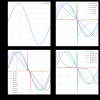The aim of the shift was to test the lock of the DRMI during the CARM offset phase with a normalized error signals for MICH, in an attempt to further increase the reliability of the lock acquisition.
According to simulations, the most promising signals for the normalization of the MICH errsig (B2_56_MHz_I) are B4_DC^2 and B2_112MHz_Mag. The simulations took in consideration both the capability of the normalization signal to extend the linear region of the PDH signal (see figure 1), and the increased robustness of the normalized error signal against optical gain loss caused by imperfect alignment of either PR or input mirrors (see figure 2 and 3).
The new normalized error signal have been added in Acl and in the DAQ and are temporarily named LSC_B2_56_MHz_I_NORM_B4_DC_SQ and LSC_B2_56_MHz_I_NORM_B2_112 respectively.
After a series of unlocks of the injection system (15.45, 15.53, 16.11, 16.19 UTC) , at 16.30 UTC a first set of attempts have been performed by locking the DRMI (with -3kHz of CARM offset) with the LSC_B2_56_MHz_I_NORM_B4_DC_SQ signal for MICH. Considering that the value of B4_DC during the previous locks 2.45 mW (see figure 4), an initial scaling factor of ~6 (2.45^2), has been used for the new normalized error signal with respect to the non normalized one. This led to an overall error signal calibration factor (mich_1f_norm_cali) of 1411.
However, such signal generated immediate saturation of the BS, PR and SR mirrors during the lock acquisition (see figure 5) . The reason of this is due to the current setting of the triggers, that often trigger when B4_DC is still quite low (~0.1 mW DC), making the normalization with B4_DC^2 magnify the error signal too much near the edges of the trigger. Attempts in tuning the gains (aggressively) and to increase the restrictivity of the triggers to avoid the saturations were unsuccesfull.
We then proceeded testing the normalization using B2_112_MHz ( LSC_B2_56_MHz_I_NORM_B2_112) instead . Using the data in figure 4 we obtained a scaling factor of ~1/115, leading to an overall error signal calibration factor (mich_1f_norm_cali) of 2. This error signal resulted in lower saturation issue than the previous one, but a second series IMC unlocks at 18.53 interrupted the first tests. A relatively long period of stability of the IMC system allowed us to perform a few additional tests with the LSC_B2_56_MHz_I_NORM_B2_112 that led in a lock of the DRMI at 20.01 UTC (which then unlocked during the handoff of to the 3f signals, see figure 6) and a second lock at 20.06 UTC, which led instad to a successfull handoff to the 3f signals. In both successfull cases, the MICH gain was lowered from 2 to 0.7 and then increased to 1.5 before the handoff. At 20.10 UTC the IMC started unlocking repeatedly again and did not allow to conclude the activity. It is not clear yet how much this normalization improves (or hampers) the reliability of the DRMI lock acquisition.
The interferometer has been left with all nodes in DOWN to avoid issues in case IMC instabilities recur again.


